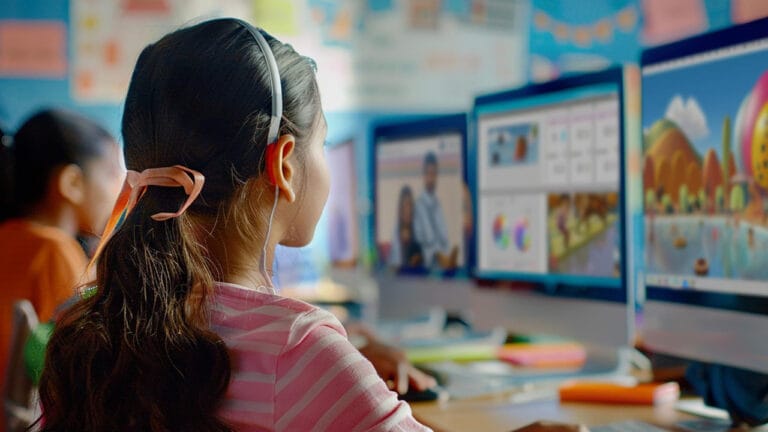Gamification taps into the psychological principles of reward-based learning, motivating employees to actively participate and acquire new skills. This method not only enhances engagement but also fosters a sense of community among coworkers. As your team navigates real-life scenarios in a risk-free setting, they receive immediate feedback, allowing them to quickly adapt and improve their processes.
By incorporating gamification into your corporate training strategy, you’re not just making learning more enjoyable; you’re leveraging proven techniques to boost retention and application of knowledge. It’s about crafting meaningful experiences that align with how people learn best—setting the stage for success in your organization.
What Is Gamification in Corporate Learning?
Gamification in corporate learning integrates game design elements into employee training programs. By incorporating points, badges, leaderboards, and challenges, it transforms traditional learning into an engaging and interactive experience. Instead of passively absorbing information, employees participate actively through self-driven activities.
This approach leverages psychological principles of reward-based learning and no one fails approach to boost motivation and engagement. Points and badges provide instant gratification for completing tasks, encouraging further participation. Leaderboards introduce a competitive aspect that fosters a sense of accomplishment among peers.
Gamified training creates real-life scenarios within a risk-free environment. Employees practice skills without fear of failure while receiving immediate feedback on their performance. This helps them quickly adapt to correct processes and enhances knowledge retention.
Furthermore, gamification promotes a culture of continuous improvement by offering clear calls to action. As employees complete challenges and earn rewards, they gain confidence in their abilities and feel more connected to the corporate culture.
Key Features of Gamification
Gamification in corporate learning transforms traditional training into an engaging experience by integrating specific game mechanics and leveraging both intrinsic and extrinsic motivations.
| Aspect | Game Mechanics | Intrinsic and Extrinsic Motivations |
|---|---|---|
| Points | Reward task completion and encourage participation. | Intrinsic: Engagement driven by personal growth and mastery. |
| Badges | Serve as tangible achievements for reaching milestones or surpassing goals. | Extrinsic: Rewards like recognition or bonuses boost participation. |
| Leaderboards | Introduce competition by showcasing top performers; reset periodically to allow new chances. | Intrinsic: Control over learning pace and progression. |
| Levels | Present new challenges after mastering basics to maintain engagement. | Extrinsic: Leaderboards enhance competitiveness and motivate continuous improvement. |
| Narratives | Enhance memory retention by incorporating storytelling into the learning process. | Intrinsic/Extrinsic: Success pathways combine personal growth with external rewards. |
Benefits of Gamification in Corporate Training
Gamification transforms corporate training by making it more engaging and effective. By integrating game elements, you can unlock multiple benefits that enhance the learning experience.
1. Increases Engagement and Motivation
Gamification boosts engagement and motivation through interactive elements like points, badges, and leaderboards. You become an active participant in your learning journey as these features create a sense of competition and achievement. Seeing your progress on leaderboards or earning rewards for achievements motivates you to continue participating actively.
2. Enhances Knowledge Retention
Game-based learning improves knowledge retention by providing immediate feedback and real-time practice opportunities. When gamified elements are included, you’re more likely to remember information by repeatedly applying it within game scenarios. This method reinforces learning concepts, ensuring that knowledge sticks long-term.
3. Promotes Social Learning
Social interaction is encouraged through gamification as you collaborate with peers while competing in training modules. Platforms supporting gamified experiences enable communication among team members, fostering a collaborative environment where ideas are shared freely. This social aspect not only enhances learning but also strengthens workplace relationships through collective problem-solving activities.
Implementing Gamification in Corporate Training
Introducing gamification in corporate training enhances employee engagement by transforming learning experiences. To effectively implement gamification, consider several key strategies.
1. Integrating with Existing Training Programs
Enhance existing programs by adding gamified elements like quizzes and point systems. Evaluate current content to identify areas where game mechanics can boost interaction and motivation. Add interactive leaderboards to create healthy competition among employees, fostering a more engaging learning environment.
2. Setting Clear Goals and Rewards
Define specific objectives within your training modules to guide employee progress. Use rewards such as points or badges to recognize achievements and milestones reached during training activities. This approach not only motivates but also provides a sense of accomplishment, encouraging further participation.
3. Encouraging Social Interaction
Incorporate team-based challenges that require collaboration among participants. Facilitate peer-to-peer communication through discussion boards or group tasks, promoting teamwork and camaraderie within the workplace culture. This social aspect strengthens relationships while enhancing the overall learning experience through shared problem-solving efforts.
Common Challenges and Mistakes
Incorporating gamification into corporate learning presents unique challenges. Missteps can diminish its effectiveness, limiting the potential benefits.
1. Over-Competition
Excessive competition can detract from learning outcomes. When leaderboards dominate the focus, employees may prioritize winning over understanding content. This emphasis on competition might alienate less competitive individuals, reducing overall engagement. Balance is key; fostering a supportive environment where collaboration complements healthy competition enhances learning experiences.
2. Misalignment with Objectives
Gamified elements that don’t align with training goals can lead to confusion and inefficiency. If game mechanics overshadow core objectives, employees may miss crucial information or skills needed for their roles. Ensure that every gamified component supports specific learning outcomes to maintain clarity and relevance in your training programs.
Practical Examples of Gamification
1. Onboarding Programs
Gamifying onboarding programs creates an engaging experience for new hires. By introducing challenges and quests, employees learn company culture and processes in a fun way. For instance, newcomers can earn points by completing tasks such as watching orientation videos or participating in team-building activities. This interactive approach helps assimilate them into the organization more smoothly while boosting their confidence from day one.
2. Compliance Training
Transforming compliance training with gamification makes it more interactive and memorable. Incorporating scenarios where employees earn points or badges for correctly navigating legal and ethical dilemmas enhances engagement. Safety games and competitions encourage employees to familiarize themselves with regulations creatively, ensuring critical information is retained efficiently without the typical monotony associated with compliance modules.
Frequently Asked Questions
1. What is gamification in corporate training?
Gamification in corporate training involves integrating game design elements like points, badges, and leaderboards into learning programs. This approach transforms traditional educational experiences into interactive and engaging activities, motivating employees to participate actively and enhancing knowledge retention.
2. How does gamification benefit employee engagement?
Gamification boosts employee engagement by making learning more interactive and competitive. It encourages active participation through reward-based motivation, fostering a sense of accomplishment and community. Employees are more likely to stay engaged when they receive immediate feedback and can see their progress.
3. Why is immediate feedback important in gamified learning?
Immediate feedback is crucial as it allows employees to understand their strengths and areas for improvement quickly. It creates a risk-free environment where individuals can practice skills without fear of failure, leading to better adaptation and continuous learning.
4. What are some key features of gamification?
Key features include points, badges, leaderboards, levels, and narrative storytelling. These elements encourage progression through training modules while enhancing memory retention by tapping into intrinsic and extrinsic motivations that empower learners.
5. How does gamification promote social learning?
Gamification fosters social learning by encouraging collaboration among peers through team-based challenges. This strengthens workplace relationships as employees engage in shared problem-solving activities that promote communication and collective achievement.
6. What should be avoided when implementing gamified training?
Avoid excessive competition that might alienate less competitive individuals or detract from learning outcomes. Ensure alignment between gamified elements and specific training objectives to maintain clarity and efficiency without causing confusion or inefficiency.
7. Can you provide examples of successful gamified corporate programs?
One example includes onboarding programs where new hires earn points for completing tasks, helping them integrate into company culture effectively. Additionally, compliance training becomes more engaging with scenarios enabling employees to navigate legal dilemmas interactively.
Final Thoughts
Gamification in corporate learning revolutionizes traditional training by making it an engaging and interactive experience. By integrating game design elements, you’re not just enhancing knowledge retention but also creating a dynamic environment that motivates and empowers your employees.
This approach fosters a sense of accomplishment and promotes continuous improvement while aligning with your organizational goals. As you implement gamified strategies, remember to balance competition with collaboration to ensure everyone benefits from the learning experience. Embrace gamification as a powerful tool to transform your corporate training programs into platforms for growth and success.


